“The Order was to Arrest All Cham People”
Witness Muy Vanny conluded his testimony today, 12 January 2016, and gave further evidence on his time in a mobile unit. Next, former Long Sword Unit leader Soy Doeun took his stance. He gave evidence on the inarrest of Cham in his commune and stated that there had been instructions “from the upper echelon” to arrest all Cham in his area.
Muy Vanny’s time in a mobile unit
The President Nil Nonn announced that the testimony of Muy Vanny would be heard today before starting the testimony of 2-TCW-988. The Trial Chamber Greffier then confirmed the presence of all parties, except the International Civil Party Lead Co-Lawyer who was absent for personal reasons, with Nuon Chea following the proceedings from the holding cell.
Khieu Samphan Defense Counsel Anta Guissé resumed her line of questioning. She asked about his work within his mobile unit that was attached to the district. She asked where this mobile unit was stationed at the time. Mr. Vanny replied that it varied. She clarified that she meant where he was stationed when the arrests took place that he had described yesterday. He replied that he was in Sdao Village in Sdao Commune. She then wanted to know whether he was alone on the oxcart. He replied that there were two or three oxcarts. They had been assigned to cut grass in another area. His mobile unit consisted of both Cham and Khmer people. She asked whether it was correct that the day when he came back from cutting grass; he was in a group with both Khmer and Cham people, which he confirmed.
She then asked whether it was correct that he had said that there were 25 Cham people and five Khmer people in his unit. He said that if he said this, he stood by his previous statement. “It happened a long time ago.” He did not know all of the people in his unit.
Ms. Guissé asked whether it was true that he did not know, under these conditions, who was Cham and was Khmer. He said that what he could recall was that all those people who were arrested were Cham. There was only a small number of Khmer in his group.
She asked who was riding the oxcarts. He replied that he was assigned to cut the grass alone. Other members were assigned to different villages within the commune.
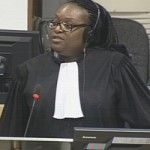
International Khieu Samphan Defense Counsel Anta Guissé
She asked whether it was dark, since he had said that he only recognized one or two people and that it was 6 pm, which he confirmed. She asked how he knew that all of them were Cham. He replied that, when he returned, all Cham people had been arrested. Ms. Guissé pressed on and asked how he could know that they were all Cham when he did not know them. He answered that he himself would have been called as well if also Khmer people were arrested. She asked whether it was correct that he was not present when the people were called together. The witness confirmed this. He also confirmed that he did not know under which conditions exactly these arrests took place.
She then inquired whether the other people on the oxcarts belonged to another unit, which he confirmed. She asked whether the two people he knew came from Sach Sau and Angkor Ban and whether he had been there already. He replied that he heard of this place later on. He had not gone there before. She asked whether he therefore did not know the Cham people in his mobile unit before working with them, since they came from these villages. He explained that it was his understanding that the Cham people were residing in Sach Sau commune.
She then inquired where the commune soldiers were stationed when he was not at the pagoda. He replied that they would usually stay at the outskirts next to a forest. He did “not know every single village”, and only knew the locations where he was stationed.
She asked whether he had actually meant the district soldiers when he said that he was generally staying with the commune soldiers. He replied that the commune soldiers were different ones than the district soldiers. Horn was responsible for the district soldiers.
The President interjected and said that he had not heard the witness referring to commune soldiers, but that the soldiers were located in the commune.
When Ms. Guissé asked whether Horn was a soldier himself, he said that Horn would sometimes stay in the center for a week and then leave to other locations to “inspect his soldiers.” When Ms. Guissé asked whether he therefore did not know Horn’s rank, which the witness confirmed, Senior Assistant Prosecutor Vincent de Wilde interjected and stated that to his understanding there were no ranks under the Khmer Rouge.
Ms. Guissé then inquired about the monk’s residence that he had mentioned. He replied that it was an old building that was situated within the compound of the pagoda. It was behind the main hall.
Interrogations
Ms. Guissé then turned to the topic of interrogations. Yesterday, he had mentioned interrogations that were carried out in a school.[1] She asked where this school was located. He replied that it was adjacent to the gate of the pagoda. It bordered the fence of the pagoda. It was outside the premise of the pagoda. She asked who carried out the interrogations. He replied that it might have perhaps been Bot or Kuon, the deputies of Horn. She drew his attention to the fact that he should only say something he knew. Ms. Guissé asked whether he therefore did not know what the functions of the people were.
Mr. de Wilde objected. Ms. Guissé rephrased the question. He confirmed that he was not involved in the interrogations, because of the duties he carried out. She asked whether he therefore also did not know the content of the interrogations, which he confirmed. She then inquired whether he therefore did not know the reasons why persons were interrogated.
Mr. de Wilde objected and said that the questions would have to be open and not closed. The objection was upheld, and the President explained that the questions had been leading.
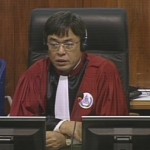
Trial Chamber President Nil Nonn
Ms. Guissé said that she was “surprised” by this decision. The President interrupted her and said that “sometimes I am lenient, but I cannot be lenient forever.” She rephrased her question. He replied that he did not know about the interrogations.
Ms. Guissé moved to her next topic and inquired about the long sword group. She asked what the difference was between the district soldiers and the members of the long sword group. He said that militiamen were there to protect the “chaotic situations” at different places while the others were stationed at one place. He did not know what the duties of the members of the long sword group were. Ms. Guissé then inquired whether he knew if there were other groups like the long sword groups in the commune, which he did not know. The long sword group was under the responsibility of Horn and the deputies.
She asked whether he knew someone called Samrit Muy under the Khmer Rouge, which he denied.[2] She asked whether he knew someone called Tay Kim Huon.[3] He said that he did not know this person at the time, but knew this person later. He confirmed that he knew Samrit Muy now, but did not know his role. With this, the Khieu Samphan Defense Counsel finished her line of questioning.
The President thanked the witness, dismissed him and adjourned the hearing for a break.
New Witness: Soy Doeun
After the break, the witness 2-TCW-988 was ushered into the courtroom.
Soy Doeun, 68 years old, was born in Dambaeng Daek, Koh Roka Commune, Kampong Siem District, Kampong Cham Province. He is a rice farmer.
The floor was then given to International Deputy Co-Prosecutor Dale Lysak. He started his line of questioning by asking about his background. In his first answer of his Written Record of Interview, he had stated that he lived in Peam Chi Kang village in 1976.
Mr. Lysak wanted to know where Mr. Doeun lived between 1975 and 1976. He said that he worked in Sambar Meah Koh in Peam Chi Kang District. Mr. Lysak asked when he moved from Kampong Siem to Peam Chi Kang and wanted to know when the Khmer Rouge took power in Peam Chi Kang. The witness could not recall it.
Mr. Lysak asked whether it was correct that he had lived in Peam Chi Kang Commune for a number of years before 1976. He replied that he lived there “while [he] was young for three years”.
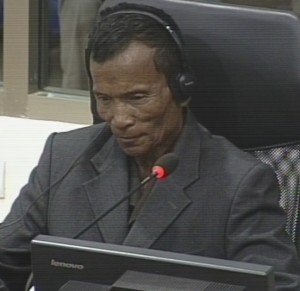
Witness Soy Doeun
Mr. Lysak said that he had indicated having been sent to Touk Chha and wanted to know the reason for this. This was located in Prey Chhor District. The poor people were sent there to work on the fields and to live in the cooperative. He lived there for three months before going to another village, since he got malaria while living there.
Mr. Lysak then inquired about the arrival of Southwest cadres in Kang Meas District and inquired what happened to the local cadres when they arrived. Some of them were arrested. They arrived in mid-1978.
Mr. Lysak read an excerpt of the Mr. Doeun’s Written Record of Interview, in which he had said that they arrived in early 1977.[4] Mr. Doeun replied that it was late 1977 or early 1978.
Mr. Lysak referred to the arrest of someone called from Chhoeun Ol alias Meas, chief of Kang Meas district before Southwest group arrived, who had been noted down on the List of Prisoners Smashed on 8 July 1977 North Zone, which listed 170 prisoners from the Old North Zone sent to S-21.[5] . The witness said that they arrested Meas “when they arrived”. Mr. Lysak said that Meas had entered S-21 on 26 February 1977. Mr. Lysak asked whether this refreshed the witness’s memory that the Southwest group arrived in early 1977 instead of late 1977 or early 1978. He said that he did not know. Kan took over control when Meas was arrested. He was the district chief. Mr. Lysak wanted to know who became the chief of Peam Chi Kang commune. He replied that it was Pheap, who was the wife of the district chief. Mr. Lysak asked whether there was someone called Khen. Mr. Doeun said that he was relocated to Reab Bay.
He recounted that there were arrests. He said that “the New People were arrested and also the Cham” when the Southwest group arrived.
Mr. Lysak asked how often Mr. Doeun saw Kan and what kind of leader Kan was. Mr. Doeun said that he could not recall it.
He had said in his interview that he saw Kan regularly – almost every day – since the commune and district office were near each other.[6] Kan was cruel, according to his interview, while his wife was “better.” Mr. Lysak asked why he had told the investigators that Kan was cruel. He replied that Kan was a cruel man: “He scolded people in the commune and in the village.” He saw him walk around. He never attended any meetings with Kan.
Mr. Lysak referred to Samrit Muy‘s interview, who had talked about a meeting at Peam Stadium, in which An and Kan were present and in which they had talked about the “enemy of the people.”[7] Mr. Lysak asked whether he remembered such a meeting that took place at a stadium. He did not know about this.
Mr. Lysak asked who served as the district security chief after the arrival of the Southwest cadres. He replied that he did not know. Mr. Lysak asked whether he remembered someone called Horn, who presided over Wat O Trakuon and was the district security chief. The witness could not remember.
This prompted Mr. Lysak to refer to his interview, in which he had said that he did not remember his name, but his face and that the office was located in Wat O Trakuon Pagoda.[8] He asked whether he saw him at Wat O Trakuon Pagoda, which Mr. Doeun confirmed. However, he did not know his name.
Long Sword Unit
Mr. Lysak asked whether Mr. Doeun was assigned to work in a Long Sword unit, which the witness confirmed. He spent two months there. He was assigned to work there by Pheap. She lived near his house, so she knew him. This was in Koh Village. This group was established after the arrival of the Southwest group. Their tasks were to control the paddy fields. He was assigned to be the village chief of Andong Sar Village in Sambour Meas Commune after having been in the Long Sword unit. It was the same as Peam Chi Kang. Pheap assigned him to be the village chief. Pheap was in the commune committee at the time.
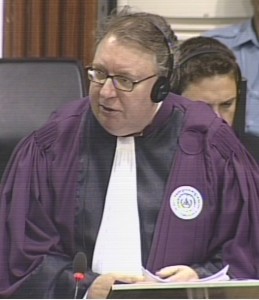
International Senior Assistant Prosecutor Dale Lysak
Mr. Lysak turned back to his time in the Long Sword unit when patrolling the village and rice paddies. He replied that he could not remember. Mr. Lysak then wanted to know whether there was another group that was patrolling alongside the Long Sword group, which the witness did not know. He reported to the commune committee. He did not remember who else was in the commune committee besides Pheap.
The witness denied that the Long Sword Unit was involved in arrests: “No, we did not make arrests.” This prompted Mr. Lysak to read out an excerpt from his Written Record of Interview. He had clearly stated that they carried out arrests and that the orders came from the district to the commune level. [9]Mr. Lysak asked whether Mr. Doeun had been truthful to the investigators when saying that they carried out arrests, which the witness confirmed. He also said that he did not know about the matter. The orders came from the district level to the commune level, down to the Long Sword Unit. They were told by the commune that the order came from the district. Mr. Lysak said that the orders came with letters. Since he could not read, Mr. Lysak asked who read out the letters. Mr. Doeun replied that it was the deputy chief. The orders were signed by Pheap.
Mr. Koppe interjected. He said that the witness had clearly said not having been involved in the arrests. When being asked whether he had been truthful to the investigators, the witness had confirmed this – which in turn meant that the witness had been untruthful before the court. Mr. Lysak said that he thought the comments were inappropriate and served to intimidate the witness. He would have time to examine the witness himself. The witness was not the first one to be reluctant to talk about their own involvement.
Mr. Lysak then referred to the witness’s statement. He had said that New People, former Lon Nol soldiers and the Cham were arrested.[10] The witness replied that former Lon Nol soldiers and New People were arrested. He did not know how the research was carried out to know who a former Lon Nol soldier was. The commune sent them to the district security. Mr. Lysak wanted to know whether all Lon Nol soldiers were arrested or only high ranking cadres. The witness replied that he did not know the details.
Mr. Lysak asked which of the three groups – former Lon Nol soldiers, New People, and Cham – was most frequently arrested when he was there. The witness replied that they were sent to the security often. When Mr. Lysak repeated the question, he said that they were Cham. They were sent to Wat O Trakuon Pagoda. The “came to receive the people at the road.” The people who received them belonged to the district security. He did not know their names, but recognized some because of their faces.
Mr. Lysak read out answer 21 of the witness’s statement and asked whether there were occasions where he brought the arrested persons through the gate into the pagoda and they were received by the guards there. He replied that he “only reached the fence and I handed over the people. I did not enter the compound.” They handed over a “thick notebook” next to a fence in which names were reported. The book was about three fingers thick. Mr. Lysak asked whether he saw the district security chief when he went there with the Long Sword Unit, which he denied. He only saw his subordinates.
Mr. Lysak asked whether any members of the Long Sword unit worked at Wat O Trakuon, which the witness denied. Mr. Lysak said that another witness had testified that sometimes Long Sword Unit members were stationed there and asked whether he was certain that no Long Sword Unit members were stationed there. The witness said that he could not remember.
Mr. Lysak asked whether he knew Muy Vanny and whether he ever saw him at Wat O Trakuon, which he denied. He knew someone called Moeun, but could not recall anything about him.
The commune office was located in Sambour Meas Ka. There were 14 members in the group. They were all wearing swords. The swords were taken from houses.
Mr. Lysak referred to an interview of another Long Sword Unit member to see whether Mr. Doeun knew the persons mentioned there and requested to present it to the witness.[11]
Ms. Guissé objected to the use of this document, since it was part of a new list subject to 87(4) request. The decision by the chamber had not been made yet. Mr. Lysak said that this request had been made long ago. It would be inefficient not to make use of the document and to call back the witness. A discussion about the use of this document followed, after which Mr. Lysak was permitted to show the names to the witness. The witness confirmed having known Meng Ly.[12] He also confirmed having worked with Heng Pha, Yun and Tay Kim Huon.
At this point, the President adjourned the hearing for a break.
Arrests
Mr. Lysak resumed his line of questioning after the break and inquired what the witness’s position was in the Long Sword Group. He replied that he was responsible for partrolling the paddy field and the villages.
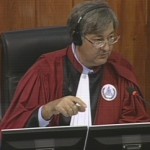
Judge Jean-Marc Lavergne
Mr. Lysak said that two other witnesses had said that the witness was the leader of the group. This person was called Tay Kim Huon.[13] The other witness, whose statement had been provided to Mr. Doeun, had also said that Mr. Doeun was a chairman.[14] Mr. Lysak sought to present this document to the witness. After conferring with the bench, the President gave the floor to Judge Jean-Marc Lavergne. He said that the Chamber had checked the request during the lunch break and that E319/19.3.226 was admitted and the reasoning would follow soon. Ms. Guissé said that one of the witnesses had said the contrary in his testimony in front of the court and rejected his earlier statement that Doeun was the superior.[15]
Mr. Lysak referred to the document again and said that the witness had also said that the group chairman was Doeun, who received orders from Khen, while his deputy was someone called An.[16] Mr. Doeun confirmed that he was the chairman. Mr. Lysak inquired whether his deputy was his deputy, which Mr. Doeun also confirmed. Mr. Lysak asked whether he knew someone called Chhor, which the witness affirmed. Ta Kim Huon was a member of the Long Sword Group.
Mr. Lysak then asked whether they were ordered to arrest Cham indiscriminately, or only people who had committed wrongdoings. He said that all Cham were arrested. The witness had previously said that with regards to Lon Nol soldiers and New People, Lon Nol & New People, only men had been arrested, while also women and children had been arrested for Cham.[17] Mr. Lysak asked why whole families were arrested with regards to Cham people, while only men were arrested in the other groups. He answered that he did not know: “I simply followed the order to make arrests.” Moreover, he recounted “Yes, we arrested both the parents and children.” The commune chief gave this order. He told them that the order came from the upper echelon. He did not know what exactly the upper echelon was.
Mr. Koppe interjected and asked for clarification whether the witness talked about “him” and “he” and referring to a female or to a man. Mr. Lysak asked whether this order came from Pheap or from another person. He confirmed that it was Pheap.
There were no Cham people left by the end of the Khmer Rouge in Peam Chi Kang Commune.
Mr. Lysak then referred to an incident that witness Seng Srun had described, in which many Cham people were arrested and sent to Wat O Trakuon. Moreover, Seng Khuy had said that he transported Cham people to Wat O Trakuon.[18] M. Lysak asked whether he had heard of this incident in which many Cham people were arrested at once. Mr. Koppe objected and said that this was a leading question. Mr. Lysak said that he had only referred to the arrests of Cham and did not talk about the killing of Cham. Mr. Lysak repeated his question. The witness said that he had not heard of such an incident.
When Mr. Doeun did not know why they were ordered to arrest the Cham people, Mr. Lysak said that witness Seng Khuy had testified on a plan to kill all the Cham.[19] Mr. Lysak asked whether he had heard of such a plan, which the witness confirmed.
He heard that “no single Cham should be spared”. The commune chief Pheap told them about this. With this, Mr. Lysak finished his line of questioning and gave the floor to his national colleague.
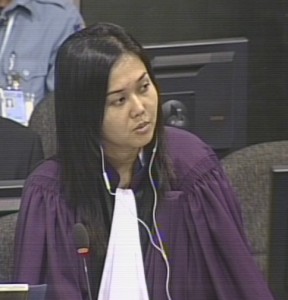
National Deputy Co-Prosecutor Song Chorvoin
National Deputy Co-Prosecutor Song Chorvoin asked how many orders he received to arrest the Cham people. He replied that he arrested Cham people only once. He received a verbal order to do so by the wife of the district committee: Pheap. “The order was to arrest all Cham people” in the village. He did not remember whether he immediately carried out the order.
She asked who read out the names to him, since he could not read. His deputy An read out the names. All the 14 members went to carry out the arrests.
Since the Civil Party Lead Co-Lawyers did not have any questions, the floor was granted to the Nuon Chea Defense Team.
Mr. Koppe asked whether his understanding was correct that the total period of his being a member of the Long Sword Unit was two months. The witness said that this was the case. Mr. Koppe asked whether this was the case, because he became village chief and could not combine both functions. Mr. Doeun replied that he was indeed appointed a village chief.
Mr. Koppe asked whether the arrest of the one-time arrest of the Cham people took place in the two months that he served in the Long Sword Unit, which the witness confirmed. The Cham arrest was the only arrest. Mr. Koppe asked how many people were arrested, which the witness did not know. The arrests were carried out in various villages – he carried it out in his village, while other people were involved in the arrests of other villages. Neither could he remember the names of these people. However, he knew them and their names at the time. They were in the village. He was transferred to Andong Sar. He confirmed that the people were not from the same village as the village that he became chief of afterwards. Mr. Koppe asked whether it was correct that he brought them to Wat O Trakuon and left them in the hands of the security guards at this pagoda. He said that he delivered them to the people at the gate. Mr. Koppe asked whether he went back to the same village or somewhere else afterwards. He replied that he returned to his place. He did not know what happened to them subsequently. Mr. Koppe asked whether it was correct that the last time he saw them was with the security guards, and never afterwards. Mr. Doeun said that he did not know “what those people did to them” and never saw them again. When Mr. Koppe asked whether he or any of his members of the group, were involved in the subsequent killings of the Cham people, he replied that they carried out the arrests. Mr. Doeun replied that he was not involved. Neither did he witness the killings.
Mr. Koppe wanted to know whether he or his group had been involved in any other killings other than those they had arrested. Doeun denied this. “However, the later group [was] involved in this matter.” He did not know about any killings later, since he was not in the group anymore.
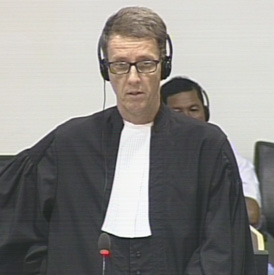
International Nuon Chea Defense Counsel Victor Koppe
Mr. Koppe asked more broadly: “have you ever witnessed with your own eyes, anybody being killed, either in your village or in your commune?” The witness said he had not. Mr. Koppe asked whether it was correct that Pheap would have received an order from her husband, which the witness confirmed. He did not hear Kan giving the orders. Mr. Koppe asked whether he was present when Kan gave the order to his wife Pheap to arrest the people that the witness arrested later. The witness replied that Pheap called a meeting and told them about the arrest. He had not heard Kan give this order to Pheap.
Mr. Koppe asked whether he ever saw Kan speak to people of the Sector, which the witness denied. Mr. Koppe asked whether the witness was in a position to know who Kan received instructions from, which the witness again denied. Mr. Koppe asked whether it was therefore correct that the only person of authority was Pheap and that he had “no knowledge” where she had the order from. He replied that he only knew that she received the orders from the upper echelon, “and that was it.” Mr. Koppe asked whether it was correct that he was not present when the upper echelon gave her the order.
Mr. Koppe moved on and asked about the arrests of New People and former Lon Nol soldiers. He asked what his source of knowledge was about these arrests if he himself had not been involved in the arrests. The witness replied that he knew about this from the commune level. When Mr. Koppe repeated the question, Mr. Lysak objected and said that it was a repetitive question. Mr. Koppe rephrased and asked what the commune level told him about the arrests. Mr. Doeun said that he “simply followed the orders from them.”
Clarifications
After the afternoon break, Mr. Koppe asked whether he was ever involved in the interrogation of “anyone who was ever arrested” between 1975 and 1979. Mr. Koppe asked whether it was fair to say that he had no knowledge as to why someone was arrested, which the witness confirmed. With this, Mr. Koppe finished his line of questioning.
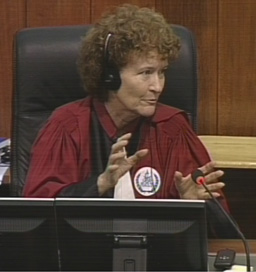
Judge Claudia Fenz
The floor was then granted to Judge Claudia Fenz. She had three questions. First, she asked whether she understood it correctly that there were other groups that carried out arrests in other villages. She asked how many other groups there were that made arrests at that time. He replied that there was another “security group”. Judge Fenz asked whether it was correct that there were two groups that carried out the arrests. He replied that the security guards were also involved in the arrests of people. He did not know them. Judge Fenz then asked in how many villages arrests had been carried out. There were seven villages in which arrests were carried out. Judge Fenz wanted to know where the other arrestees were brought to. He replied that they were sent to the same place. She further wanted to know who the people were who were arrested: were they Cham or Khmer? He replied that they were only Cham. This happened in one day. He could not recall how many people were arrested. “It was probably two people who were arrested.” He did not know how many people were arrested by the other six groups, since they did not speak to each other. He saw the arrested people being sent along the road and sent to the place. Sometimes, two or three people were brought. He did not know what the biggest group of people was that he saw were arrested.
Second, she asked what he had meant when saying what the “later group” did that killed people. He said that it was the security guards’ group. She asked whether this was the same group that also arrested people at the same time as his group. He replied that they knew they would arrest people when they saw them riding bicycles. He knew that they killed people, because he heard them talk about it. He did not hear any screams. Judge Fenz asked whether they told him directly that they had killed people or did they tell someone else who in turn told him. He replied that those who arrested people – the group consisted of around 15 people in total – were the ones who killed people. They would go out in group of five to arrest people. He said that he “heard it from their mouths” that they killed people. They said that the killing took place in Wat O Trakuon.
Third, she recounted that he had said that the order to arrest Cham came from Pheap, who in turn received it from the upper echelon. She asked who told him that Pheap got the order from the husband. He said that Pheap herself had told them: she said that she went to a meeting with the upper level, who had given her the order. She did not specify any names.
The floor was then granted to the Khieu Samphan Defense Counsel. Mr. Kong Sam Onn asked whether they carried out arrests in one or in two villages. The witness said that his group stayed together as a group and did not split up, as Kong Sam Onn had suggested before. They all went together to carry out the arrests.
Mr. Sam Onn then asked to specify the time that his unit was established. Mr. Doeun replied that he did not know, because he “could not read and write.” He was the “original member” of his group. The arrest took place in late 1978, but he could not remember the month. Mr. Sam Onn inquired whether he knew that the Long Sword Unit also exited in other villages. He answered that he did not know. Neither did he attend a meeting with other Long Sword Unit members from other regions. He denied this and said that he only attended meetings at the commune level.
The President adjourned the hearing. It will continue tomorrow, 9 am, with the testimony of 2-TCW-928.
[1] Testimony of Muy Vanny, January 11 2016, at 13:47. [2] Testimony of 15 September 2015. [3] 2-TCW-873. Testimony of 16 September 2015. [4] E319/19.3.95, at answer 30. [5] E3/3861, number 35. [6] E319/19.3.95, at answer 16. [7] E3/9346, 00235016 (KH), 00235508 (EN), 00283948 (FR). [8] E319/19.3.95, answer 5. [9] E319/19.3.95, answer 17. [10] E319/19.3.95, at answer 18. [11] E319/19.3.226. [12] This name should have not been read out by the witness. [13] E3/5257, at 00243105 (KH), 00251018 (EN), 00342670 (FR). [14] E319/19.3.226 , answers 4 and 6. [15] E1/348.1, at 11:08. [16] E319/19.3.226, answers 4 and 6. [17] E319/19.3.95, at answer 34. [18] E1/346.1, until 11:02:18. Testimony of Seng Khuy, 14 September 2015. [19] E1/345.1, at 10:17:48. Testimony of Seng Khuy, 10 September 2015.
Featured Image: Witness Soy Doeun (Courtesy: ECCC Flickr)
